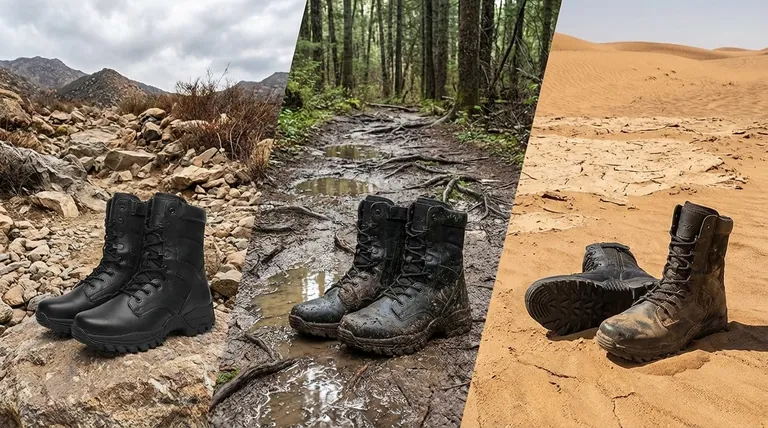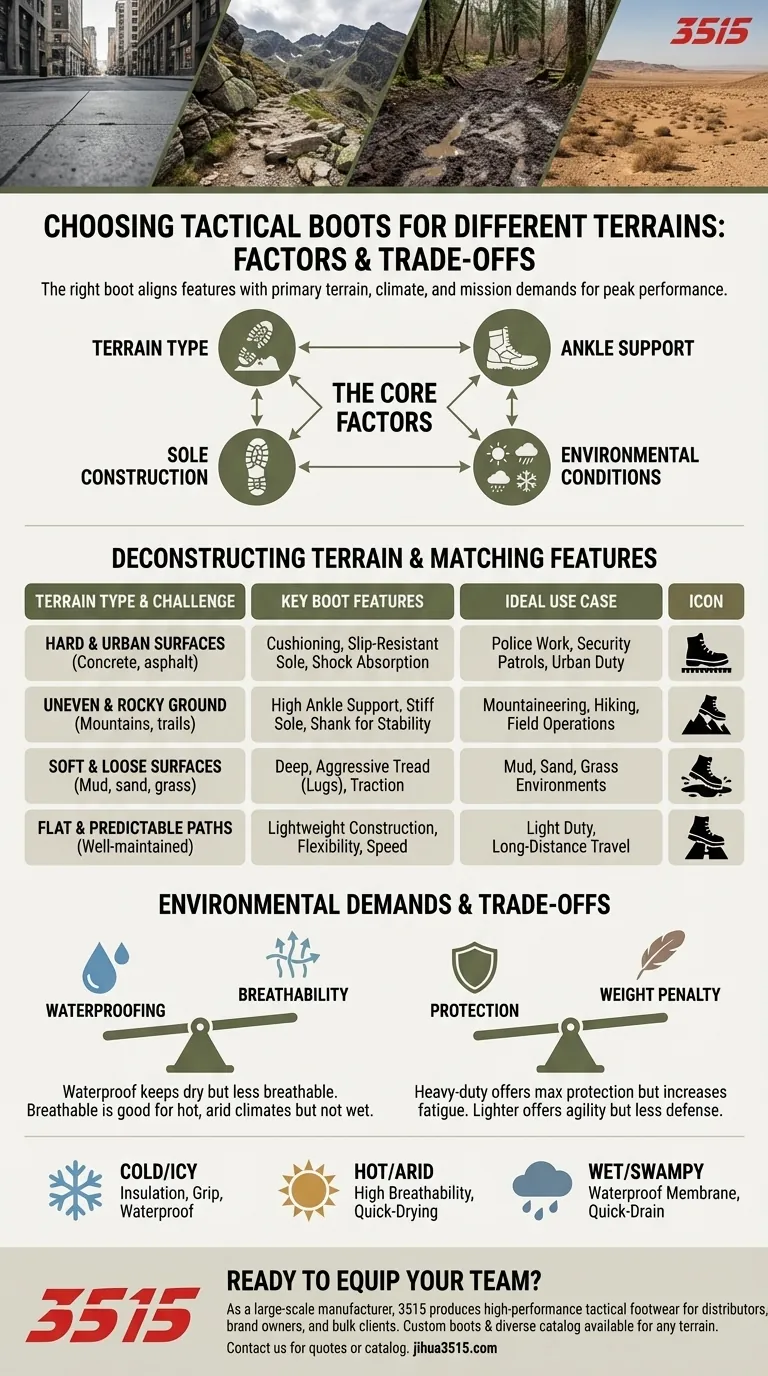When choosing tactical boots, the most critical factors are the specific terrain you will operate in, the required level of ankle support, the necessary sole construction for grip and stability, and the environmental conditions you expect to face, such as water, heat, or cold. These elements dictate whether you need a rigid, supportive boot for mountains or a flexible, cushioned one for urban environments.
The goal is not to find one perfect boot for all situations, but to precisely match the boot's features—its sole, ankle height, and materials—to the primary terrain and climate you will face. This alignment is the key to maximizing performance, ensuring comfort, and preventing injury.

Deconstructing the Terrain: The Foundation of Your Choice
The surface under your feet is the single most important variable. Different terrains place vastly different demands on your footwear, and a mismatch can lead to fatigue, loss of traction, or injury.
Hard & Urban Surfaces
On hard, man-made surfaces like concrete or asphalt, cushioning and slip resistance are paramount. The repetitive impact requires a sole that can absorb shock effectively to reduce stress on your joints.
Police boots are often designed for this context, with tread patterns that maximize surface contact for grip on flat, potentially slick ground.
Uneven & Rocky Ground
For rocky trails, mountains, or broken ground, your priorities shift to stability and protection. A boot with a stiffer sole and a thick shank provides a stable platform, preventing your foot from flexing over sharp rocks or narrow ledges.
High or mid-cut designs are essential here to provide robust ankle support, locking the joint in place to prevent twists and sprains.
Soft & Loose Surfaces
In environments like sand, mud, or deep grass, traction is the primary concern. Boots with deep, aggressive treads (lugs) are necessary to dig into the soft ground and provide a secure foothold.
Without this specialized tread, you will expend significantly more energy just to remain stable and move forward.
Flat & Predictable Paths
On well-maintained trails or flat ground, you can prioritize lightweight construction and flexibility. A heavy, rigid boot is unnecessary and will only lead to faster fatigue.
In these conditions, lighter tactical boots or even tactical trail runners offer sufficient support while maximizing speed and comfort.
Matching Boot Features to Environmental Demands
Beyond the ground itself, you must consider the climate and potential hazards of your operational environment.
The Critical Role of Ankle Support
Ankle height is a direct response to terrain instability. High-cut boots are non-negotiable for load-bearing activities on uneven ground, as they protect against dangerous ankle rolls.
Mid or low-cut boots offer greater mobility and are suitable for flatter, more predictable surfaces where the risk of a misstep is lower.
Sole Stiffness vs. Flexibility
A rigid sole is a tool for stability in challenging terrain. It creates a solid platform that minimizes foot fatigue when navigating rocks or side-hilling on steep slopes.
A flexible sole allows your foot to move more naturally, which is ideal for running, climbing, or fast movement on even ground where you need to feel the surface beneath you.
Waterproofing and Breathability
For wet, rainy, or swampy environments, a waterproof membrane is essential to keep your feet dry and prevent blisters.
However, in hot and arid climates, breathability is more important. A waterproof boot will trap sweat, leading to moisture issues. In this case, a desert boot or a highly breathable, non-waterproof option is superior. For hot, humid conditions, a jungle boot is designed to let water in but also drain and dry extremely quickly.
Insulation for Cold & Icy Conditions
For operations in snow or freezing temperatures, insulated boots are required to prevent frostbite and maintain comfort.
These boots are almost always waterproof and feature thick soles with specialized rubber compounds and tread patterns designed to grip snow and ice.
Understanding the Trade-offs: No Single Boot Does It All
Choosing a tactical boot is an exercise in managing compromises. Excelling in one area often means sacrificing performance in another. Understanding these trade-offs is crucial for making an informed decision.
The Waterproofing vs. Breathability Dilemma
A truly waterproof boot is, by nature, less breathable. While it keeps external water out, it can also trap sweat inside, leading to damp feet in hot weather. A highly breathable boot will feel great in the desert but will be useless in a downpour.
The Protection vs. Weight Penalty
A heavy-duty boot with a stiff sole and high ankle support offers maximum protection on rugged terrain. However, that protection comes with a significant weight penalty, increasing fatigue and reducing agility over long distances.
Specialized vs. General-Purpose
A boot designed for a specific niche, like a jungle boot or an insulated winter boot, will perform exceptionally in that environment. However, it will likely be uncomfortable or even unsafe if used outside of its intended context. A more general-purpose boot offers versatility but won't be the top performer in any single extreme environment.
Making the Right Choice for Your Mission
Evaluate your most common operational environment and select the boot that aligns with those specific demands.
- If your primary focus is urban operations: Prioritize a boot with excellent cushioning, a slip-resistant outsole for flat surfaces, and moderate flexibility.
- If your primary focus is mountainous or rugged terrain: Demand a boot with high ankle support, a stiff sole for stability, and durable, protective construction.
- If your primary focus is wet or constantly changing weather: Select a boot with a reliable waterproof membrane to ensure your feet stay dry and functional.
- If your primary focus is hot, arid climates: Choose a lightweight, highly breathable boot to maximize ventilation and prevent your feet from overheating.
Ultimately, the right tactical boot is the one that becomes an extension of your body, allowing you to focus on the mission, not on your feet.
Summary Table:
| Terrain Type | Key Boot Features | Ideal Use Case |
|---|---|---|
| Hard & Urban Surfaces | Cushioning, Slip-Resistant Sole | Police Work, Security Patrols |
| Uneven & Rocky Ground | High Ankle Support, Stiff Sole | Mountaineering, Hiking, Field Operations |
| Soft & Loose Surfaces | Deep, Aggressive Tread (Lugs) | Mud, Sand, Grass |
| Flat & Predictable Paths | Lightweight, Flexible Construction | Light Duty, Long-Distance Travel |
| Wet/Cold Conditions | Waterproof Membrane, Insulation | Rain, Snow, Freezing Temperatures |
| Hot/Arid Conditions | High Breathability, Quick-Drying | Desert, Arid Climates |
Ready to equip your team with mission-specific tactical boots?
As a large-scale manufacturer, 3515 produces a comprehensive range of high-performance tactical footwear for distributors, brand owners, and bulk clients. Our production capabilities encompass all types of boots tailored to any terrain—from urban duty to extreme environments.
We can help you:
- Develop custom boots perfectly suited to your operational needs and target market.
- Access a diverse catalog of proven designs for immediate bulk ordering.
- Ensure superior quality and durability with our extensive manufacturing expertise.
Let's discuss your specific requirements. Contact our team today to get a quote or request a catalog.
Visual Guide

Related Products
- Durable Leather Tactical Boots Wholesale & Custom Manufacturing for Brands
- Wholesale Waterproof Tactical Boots Custom Suede & High-Traction Soles
- Durable Leather High-Ankle Tactical Boots for Wholesale & Custom Manufacturing
- Wholesale Lightweight Tactical Boots with Dial Closure OEM & Bulk Orders
- High-Traction Suede Tactical Boots Wholesale & Custom Manufacturing
People Also Ask
- How do tactical boots and regular shoes differ in cushioning and padding? Unlock the Key to Performance & Protection
- What are the primary uses of tactical boots? Essential Footwear for Demanding Professionals
- How do tactical boots differ from regular footwear? A Guide to Purpose-Built Performance
- Why is conditioning important for full grain leather tactical boots? Prevent Cracking & Ensure Longevity
- What is the function of the insole in tactical boots? A Guide to Foot Support & Performance



















